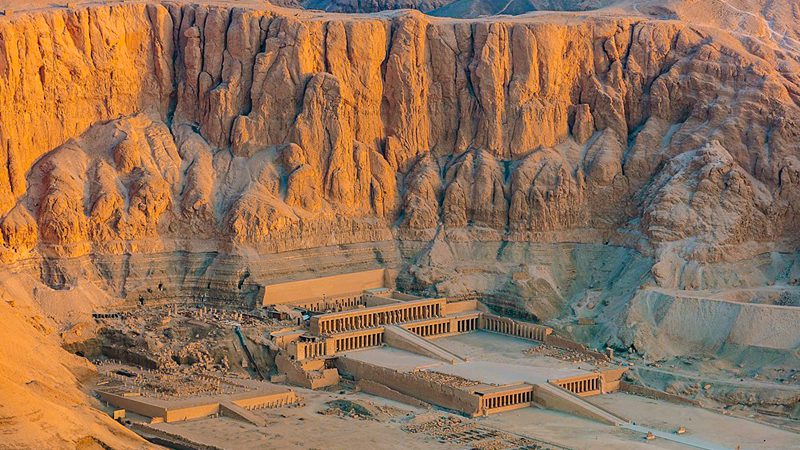Welcome to the captivating world of the Temple of Hatshepsut, which testifies to the greatness and development of the ancient Egyptian civilization. Nestled amid the rugged cliffs of Deir el-Bahari near Luxor, this stunning monument is a magnificent tribute to the reign of Queen Hatshepsut, one of Egypt’s most famous pharaohs. Join us on a virtual journey as we delve into the captivating history, stunning architecture, and enduring legends surrounding the magnificent Temple of Hatshepsut.


Disclosure of historical significance
To truly appreciate the Temple of Hatshepsut, we must first understand its historical context. Hatshepsut, daughter of Thutmose I, came to power in the 15th century BC. As the fifth pharaoh of the Eighteenth Dynasty, Hatshepsut’s reign was marked by remarkable achievements, including extensive trade campaigns and a focus on massive building projects. Unusually for her era, Hatshepsut assumed the title of pharaoh, effectively becoming the first female ruler of ancient Egypt.
Stunning architecture
The architectural marvels of the Temple of Hatshepsut continue to amaze visitors from all over the world. Built on multiple terraces against limestone cliffs, the temple blends seamlessly into the landscape. The exquisite columned design, featuring intricate carvings and towering statues, is a testament to the mastery of ancient Egyptian architects.
The majestic mortuary temple
The Temple of Hatshepsut, also known as Djeser-Djeseru (Holy of Holies), was a mortuary temple dedicated to worshiping Amun-Ra, the king of the gods. Its purpose was to honor the Queen’s divine lineage and facilitate her eternal journey in the afterlife. We’ll explore the temple’s layout, sacred spaces, and the beautiful rituals and ceremonies within its sacred walls.
The riddle of Queen Hatshepsut
Immerse yourself in the fascinating life of Queen Hatshepsut, a powerful and enigmatic ruler who defied tradition to take the throne. We’ll uncover the mysteries surrounding her reign, her architectural vision, and the challenges she faced as a female pharaoh in ancient Egypt. Discover the enduring legacy of Hatshepsut as a remarkable ruler and a symbol of female empowerment.
Interesting legends and stories
Ancient Egypt is steeped in myths, and the Temple of Hatshepsut is no exception. From stories of divine birth to tales of hidden treasure, we’ll explore the intriguing myths and folklore associated with the temple. Discover the secrets that have fascinated historians and archaeologists for centuries, and immerse yourself in the captivating traditions that envelop the Temple of Hatshepsut.
Conclusion :
The Temple of Hatshepsut is a testament to ancient Egypt’s architectural brilliance and cultural richness. Its majestic structure and rich history continue to captivate visitors, offering a glimpse into the splendor of a bygone era. From the stunning architecture to the fascinating legends surrounding it, the Temple of Hatshepsut is a must-visit destination for history buffs, archeology enthusiasts, and curious travelers seeking to unlock the mysteries of the ancient world.
Embark on a journey through time and discover the wonders of the Temple of Hatshepsut, an enduring symbol of Egypt’s glorious past. Immerse yourself in the grandeur of this ancient architectural masterpiece, and let the stories of the pharaohs and their extraordinary achievements transport you to a bygone era. Experience the magic of Hatshepsut Temple and create memories that will last a lifetime.
What is the significance of Hatshepsut Temple in ancient Egyptian history?
Hatshepsut Temple holds great historical significance as it showcases the reign of Queen Hatshepsut, the first female pharaoh of ancient Egypt. It provides valuable insights into her remarkable accomplishments, architectural vision, and the cultural landscape of the time.
How can I visit Hatshepsut Temple, and where is it located?
Hatshepsut Temple is located near Deir el-Bahari, near Luxor in Egypt. Visitors can reach the temple by various means of transportation, including organized tours, private cars, or public buses. It is advisable to check with local travel agencies or tourist information centers for the most up-to-date guidance and directions.
What architectural features make Hatshepsut Temple unique?
Hatshepsut Temple is renowned for its impressive architecture, with multiple terraces, grand colonnades, and intricate reliefs. The seamless integration of the temple with the natural landscape and the towering statues of pharaohs make it a true marvel. Visitors can witness the mastery of ancient Egyptian architects through the temple’s design and construction.
Are there any specific rituals or ceremonies associated with Hatshepsut Temple?
Hatshepsut Temple served as a mortuary temple dedicated to the worship of Amun-Ra, the king of gods. Although the specific rituals performed in ancient times may not be practiced today, visitors can explore the temple’s sacred spaces and imagine the solemn ceremonies that once took place within its hallowed walls.
What are some exciting legends or myths surrounding Hatshepsut Temple?
Hatshepsut Temple is enveloped in captivating legends and intriguing stories. From tales of hidden treasures to accounts of divine birth, these myths add to the allure and mystique of the temple. Exploring the fascinating folklore surrounding Hatshepsut Temple is a captivating aspect of the visit.
Can I learn more about Queen Hatshepsut and her reign at the temple?
Absolutely! Queen Hatshepsut’s life and reign are fascinating subjects of study. Visitors can delve deeper into her remarkable story, achievements as a female pharaoh, and challenges during her rule. The temple provides valuable insights into her legacy and enduring impact on ancient Egyptian history.
